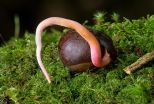(Press-News.org) A new treatment for Marfan syndrome, a rare genetic disease that can lead to heart problems, works as well as the currently recommended medical therapy, beta blockers, according to an article in the New England Journal of Medicine.
Angela Sharkey, M.D., professor of pediatrics at Saint Louis University, and a study author, said researchers found losartan, which had been more effective in an animal model of Marfan syndrome, was equally effective to a high dose of the beta blocker atenolol.
"While there may be certain patients who respond better to one drug or another, we found no evidence that losartan is superior to atenolol, a beta blocker currently prescribed for Marfan syndrome," said Sharkey, who was honored earlier this year as the Marfan Foundation's Hero with a Heart. "Losartan appears to be a reasonable alternative treatment for patients who can't take beta blockers, which could give physicians another option to treat a rare and debilitating genetic disease."
Both medications are designed to relax the blood vessels so the heart doesn't have to work as hard to pump blood through the body. Atenolol slows the heart rate, which decreases blood pressure and losartan prevents certain natural substances in the body from tightening the blood vessel walls.
The multi-site, NIH-funded trial followed 608 patients between ages 6 months and 25 years who had enlarged aortas (the main artery carrying blood to the body) for three years. All received either losartan, the investigational medication, or a higher dose of atenolol than is typically prescribed.
Patients in both treatment groups showed no difference in the rate of growth of their aortas.
Additionally, the incidence of aortic-root surgery, aortic dissection, or death did not differ between treatment groups.
Affecting 1 in 5,000 people, Marfan syndrome is a disease that affects the body's connective tissues. Those who have Marfan syndrome typically are tall and thin, with long limbs. Marfan syndrome can take a toll on many different parts of the body including the heart, blood vessels, bones and eyes.
The most serious cardiac issue, enlargement of the aorta, can be life-threatening as it can lead to dissection or tearing of the aorta. While there is no cure for Marfan syndrome, the cardiac aspects of the disease are managed with medication and prophylactic surgical therapy.
INFORMATION:
The lead author of the research paper is Ronald Lacro, M.D., Boston Children's Hospital. Other members of the research team include Harry Dietz, M.D., Johns Hopkins University School of Medicine and McCusick-Nathans Institute for Genetic Medicine; Lynn Sleeper, Sc.D. and Shan Chen, New England Research Institutes; Anji Yetman, M.D., Primary Children's Medical Center and the University of Utah; Timothy Bradley, M.B., Ch.B., and Elizabeth Radojewski, The Hospital of Sick Children; Steven Colan, M.D., Children's Hospital Boston; Gail Pearson, M.D., Sc.D., Victoria Pemberton and Mario Stylianou, Ph.D., National Institutes of Health; Tierney Selamet, M.D., Elif Seda, Lucile Salter Packard Children's Hospital; Jami Levine, M.D., and Gloria Klein, Boston Children's Hospital; Andrew Atz, M.D., Medical University of South Carolina; D. Benson, M.D., Children's Hospital of Wisconsin; Alan Braverman, M.D., Washington University School of Medicine; Julie De Backer, M.D., Ph.D., Ghent University Hospital, Centre for Medical Genetics; Bruce Gelb, M.D., Mount Sinai School of Medicine, Child Health and Development Institute; Paul Grossfeld, M.D., Rady Children's Hospital; Wyman Lai, M.D., Children's Hospital of New York; Aimee Liou, M.D., Texas Children's Hospital; Bart Loeys, M.D., Antwerp University Hospital and the University of Antwerp; Larry Markham, M.D., Vanderbilt School of Medicine; Aaron Olson, M.D., Seattle Children's Research Institute; Stephen Paridon, M.D., Children's Hospital of Philadelphia,; Mary Pierpont, M.D., Children's Hospital and Clinics of Minnesota; Reed Pyertiz, M.D., Ph.D., University of Pennsylvania School of Medicine; Mary Roman, M.D., Weill Cornell Medical College; Stephanie Wechsler, M.D., Duke University Medical Center; Luciana Young, M.D., Anne & Robert H. Lurie Children's Hospital of Chicago; and Lynn Mahony, M.D., University of Texas Southwestern Medical Center.
The paper was presented at the American Heart Association meeting on Tuesday, Nov. 18 and is slated to appear in the print edition of the New England Journal of Medicine on Thursday, Nov. 27.
Established in 1836, Saint Louis University School of Medicine has the distinction of awarding the first medical degree west of the Mississippi River. The school educates physicians and biomedical scientists, conducts medical research, and provides health care on a local, national and international level. Research at the school seeks new cures and treatments in five key areas: infectious disease, liver disease, cancer, heart/lung disease, and aging and brain disorders.
Researchers from the University of Melbourne found unlike other laser treatments, this new faster laser did not result in damage to the retina, the sensitive light detecting tissue at the back of the eye.
Associate Professor Erica Fletcher from the Department of Anatomy and Neuroscience said this was the first report detailing how this new laser treatment may improve eye health in those with AMD. In the early stages, the disease is characterised by the presence of small fatty deposits called drusen and thickening in a membrane at the back of the eye.
Published this ...
Barcelona, Spain: A new drug that targets not only common cancer-causing genetic mutations in patients with non-small cell lung cancer (NSCLC), but also a form of the mutation that causes resistance to treatment, has shown promising results in patients in a phase I/II clinical trial. The research will be presented today (Friday) at the 26th EORTC-NCI-AACR Symposium on Molecular Targets and Cancer Therapeutics in Barcelona, Spain.
Approximately 10-15% of Caucasian and 30-35% of Asian patients with NSCLC have a mutation in the epidermal growth factor receptor (EGFR), which ...
If it's help a woman needs, maybe she should wear high heels. That's the message from Nicolas Guéguen of the Université de Bretagne-Sud in France, after he observed how helpful men are towards women in high heels versus those wearing flat, sensible shoes. The study, published in Springer's journal Archives of Sexual Behavior, is the first ever to investigate how the height of a woman's shoe heel influences how men behave towards her.
Research across various cultures has shown at length how important physical features, such as body size and the style and color ...
Approximately 40 percent of the earth's surface is covered by drylands in which average annual precipitation is lower than evaporation. The changes projected to unfold in these areas in the course of climate change are alarming. Greater variations in annual and seasonal precipitation will lead to more frequent droughts and, presumably, longer drought periods. This means that drylands are among those areas most severely affected by climate change.
Research has thus far not adequately addressed the question of how strongly annual plant growth in pasture landscapes - hence ...
Time ravages mountains, as it does people. Sharp features soften, and bodies grow shorter and rounder. But under the right conditions, some mountains refuse to age. In a new study, scientists explain why the ice-covered Gamburtsev Mountains in the middle of Antarctica looks as young as they do.
The Gamburtsevs were discovered in the 1950s, but remained unexplored until scientists flew ice-penetrating instruments over the mountains 60 years later. As this ancient hidden landscape came into focus, scientists were stunned to see the saw-toothed and towering crags of much ...
Researchers from China, the Philippines and LSTM have today published a new systematic review of reminder systems to improve patient adherence to tuberculosis (TB) treatment. Reminder systems include prompts in advance of a forthcoming appointment to help ensure the patients attend, and also actions when people miss an appointment, such as phoning them or arranging a home visit. This review is the latest in a suite of reviews produced by authors from the Cochrane Infectious Diseases Group, hosted at LSTM, evaluating interventions to improve adherence to TB treatment. Effective ...
Washington, D.C. - November 19, 2014 - Lumosity is presenting new research today at the 2014 Society for Neuroscience conference on how lifestyle factors such as sleep, mood and time of day impact cognitive gameplay performance. The study, titled "Estimating sleep, mood and time of day effects in a large database of human cognitive performance," analyzed over 60 million data points from 61,407 participants and found that memory, speed, and flexibility tasks peaked in the morning, while crystallized knowledge tasks such as arithmetic and verbal fluency peaked in the afternoon. ...
An international team of scientists, coordinated by a researcher from the U. of Granada, has found that seed dormancy (a property that prevents germination under non-favourable conditions) was a feature already present in the first seeds, 360 million years ago.
Seed dormancy is a phenomenon that has intrigued naturalists for decades, since it conditions the dynamics of natural vegetation and agricultural cycles. There are several types of dormancy, and some of them are modulated by environmental conditions in more subtle ways than others.
In an article published in the ...
Quasars are galaxies with very active supermassive black holes at their centres. These black holes are surrounded by spinning discs of extremely hot material that is often spewed out in long jets along their axes of rotation. Quasars can shine more brightly than all the stars in the rest of their host galaxies put together.
A team led by Damien Hutsemékers from the University of Liège in Belgium used the FORS instrument on the VLT to study 93 quasars that were known to form huge groupings spread over billions of light-years, seen at a time when the Universe ...
PROVIDENCE, R.I. [Brown University] -- A widely presumed problem of aging is that the brain becomes less flexible -- less plastic -- and that learning may therefore become more difficult. A new study led by Brown University researchers contradicts that notion with a finding that plasticity did occur in seniors who learned a task well, but it occurred in a different part of the brain than in younger people.
When many older subjects learned a new visual task, the researchers found, they unexpectedly showed a significantly associated change in the white matter of the brain. ...


